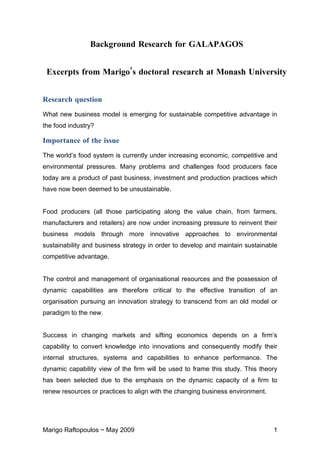Research Excerpts For Galapagos
- 1. Background Research for GALAPAGOS Excerpts from Marigo’s doctoral research at Monash University Research question What new business model is emerging for sustainable competitive advantage in the food industry? Importance of the issue The world’s food system is currently under increasing economic, competitive and environmental pressures. Many problems and challenges food producers face today are a product of past business, investment and production practices which have now been deemed to be unsustainable. Food producers (all those participating along the value chain, from farmers, manufacturers and retailers) are now under increasing pressure to reinvent their business models through more innovative approaches to environmental sustainability and business strategy in order to develop and maintain sustainable competitive advantage. The control and management of organisational resources and the possession of dynamic capabilities are therefore critical to the effective transition of an organisation pursuing an innovation strategy to transcend from an old model or paradigm to the new. Success in changing markets and sifting economics depends on a firm’s capability to convert knowledge into innovations and consequently modify their internal structures, systems and capabilities to enhance performance. The dynamic capability view of the firm will be used to frame this study. This theory has been selected due to the emphasis on the dynamic capacity of a firm to renew resources or practices to align with the changing business environment. Marigo Raftopoulos ~ May 2009 1
- 2. I anticipate that this case study will add to this current body of knowledge by gaining an insight into the capabilities, enablers and constraints experienced by firms in this industry pursuing a strategy of sustainable competitive advantage. Description of the research project The backdrop to the case study is shaped by the following key environmental developments that affect a firm’s sustainable competitive advantage in this industry: Current food systems are not sustainable over the long term Current agricultural systems are highly productive however this abundance is based on an unsustainable use of natural resources and fossil fuels. The developed world has succeeded in developing an inexpensive, efficient food production and delivery system, however over-consumption and lowered nutritional value have negative impacts on soil and water resources and human health. Furthermore food in the developed world is readily available and inexpensive in part because we have ignored the cost of natural resource depletion and non- renewable fossil fuel use while calculating the cost of production. In light of changing constraints to agricultural production, questions arise as to future advances in agricultural productivity, not from the standpoint of abundance but of sustainability. Emerging technologies will need to address issues of economic and environmental sustainability, shifts in global population and consumption patterns and competition for land use. While technology has helped realise abundance and productivity gains, future advances will require a different mindset to better balance environmental and production goals and keep production economically viable. Dynamic capability is emerging as a key driver of sustainable competitive advantage Marigo Raftopoulos ~ May 2009 2
- 3. The dynamic capabilities view of the firm is the evolutionary extension of the resource-based view perspective as it explicitly looks at how capabilities evolve and how organisations deal with environmental turbulence emanating from technological advances, changes in consumer demand and new regulations. Dynamic capability is an organisation’s collective ability to create sustainable competitive advantage by developing, maintaining and renewing its capabilities through continuous learning buy leveraging individual, organisational and environmental elements such as resources, skills, systems, structure and culture. Organisations may possess resources but must display dynamic capabilities otherwise they will destroy value. Shifting paradigms for sustainable business development require changes in business practices Sustainable view of the firm is based on the need for firms to integrate natural and social elements due to the fact that the business world is part of a larger system. The implications for this is the acceptance of the scarcity of natural resources and the role of business to build & protect social resources. Much of this is driven by changing social expectations towards business action and responsibilities. The adaptation of businesses to these changing expectations by developing a more sustainable development business model will also be a future source of competitive advantage. Researchers are now revisiting the importance of triple bottom line approach to business development and management. Expected learning outcomes • Identify the necessary capabilities used by companies to pursue a sustainable competitive advantage strategy, and how this may have changed or might change over time (what they have used in the past, what they use now and what they expect to use in the future). Marigo Raftopoulos ~ May 2009 3
- 4. • Identify which environmental (internal or external) drivers have prompted a shift needed in capabilities of the firm to stay on track with their strategy. • Gain an understanding of the enablers and constraints experienced by these companies in pursuing a strategy of sustainable competitive advantage. • Describe the models that these businesses have implemented or ‘operationalised’ and compare these to the conceptual models presented in the literature. Marigo Raftopoulos ~ May 2009 4




